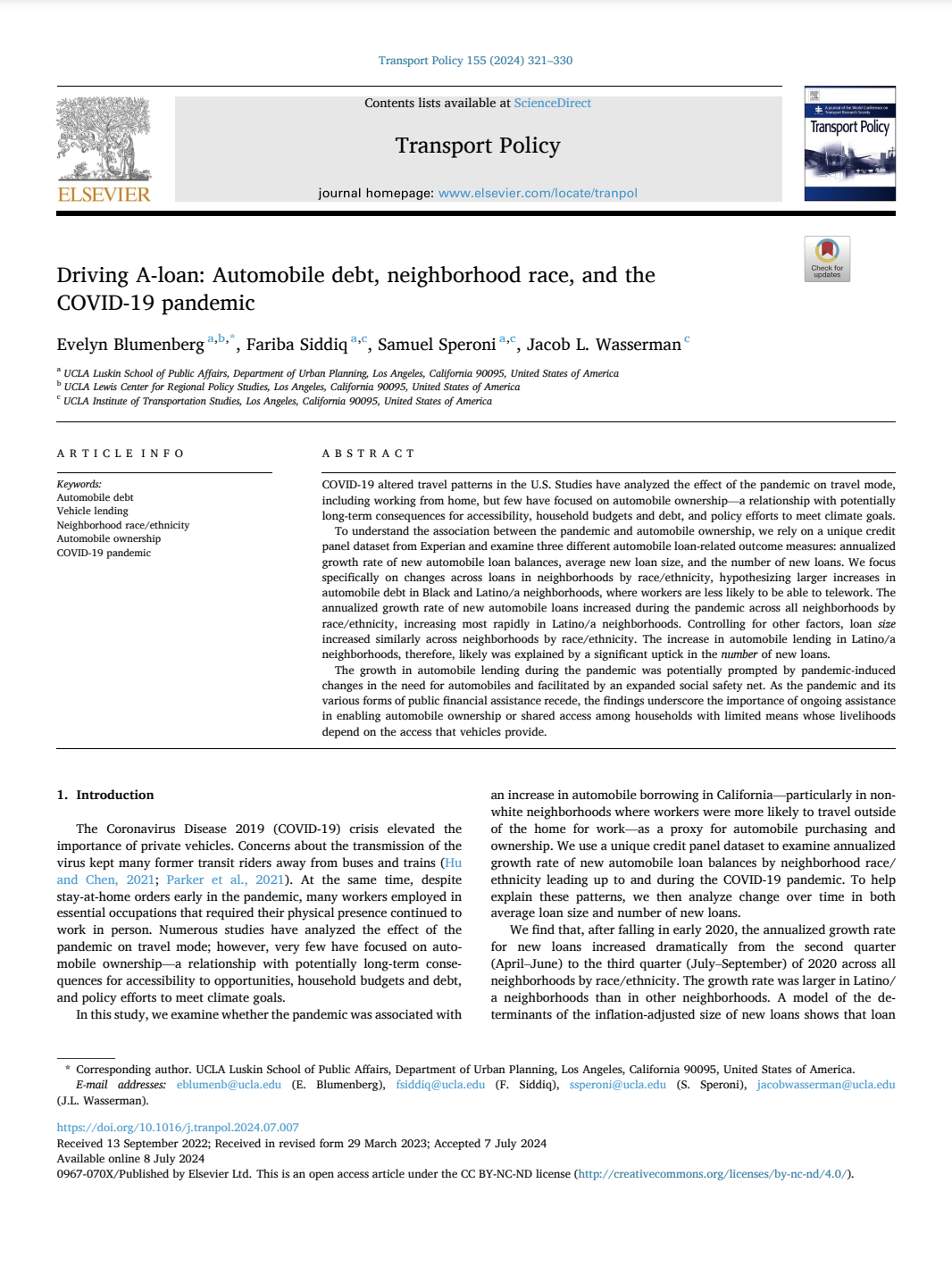Date: September 1, 2024
Author(s): Evelyn Blumenberg, Fariba Siddiq, Samuel Speroni, Jacob L. Wasserman
Abstract
COVID-19 altered travel patterns in the U.S. Studies have analyzed the effect of the pandemic on travel mode, including working from home, but few have focused on automobile ownership—a relationship with potentially long-term consequences for accessibility, household budgets and debt, and policy efforts to meet climate goals.
To understand the association between the pandemic and automobile ownership, we rely on a unique credit panel dataset from Experian and examine three different automobile loan-related outcome measures: annualized growth rate of new automobile loan balances, average new loan size, and the number of new loans. We focus specifically on changes across loans in neighborhoods by race/ethnicity, hypothesizing larger increases in automobile debt in Black and Latino/a neighborhoods, where workers are less likely to be able to telework. The annualized growth rate of new automobile loans increased during the pandemic across all neighborhoods by race/ethnicity, increasing most rapidly in Latino/a neighborhoods. Controlling for other factors, loan size increased similarly across neighborhoods by race/ethnicity. The increase in automobile lending in Latino/a neighborhoods, therefore, likely was explained by a significant uptick in the number of new loans.
The growth in automobile lending during the pandemic was potentially prompted by pandemic-induced changes in the need for automobiles and facilitated by an expanded social safety net. As the pandemic and its various forms of public financial assistance recede, the findings underscore the importance of ongoing assistance in enabling automobile ownership or shared access among households with limited means whose livelihoods depend on the access that vehicles provide.
About the Project
Most U.S. metropolitan areas developed alongside the automobile. Consequently, access to opportunities in these neighborhoods is predicated on having an automobile, yet many households do not have the resources to purchase one outright, relying on automobile loans to spread out the purchase price. Moreover, COVID-19 altered travel patterns in the U.S. Few studies have focused on automobile ownership—a relationship with potentially long-term consequences for accessibility, household budgets and debt, and policy efforts to meet climate goals. To understand the association between the pandemic and automobile ownership, this project first examines three different automobile loan-related outcome measures: annualized growth rate of new automobile loan balances, average new loan size, and the number of new loans. The annualized growth rate of new automobile loans increased during the pandemic across all neighborhoods by race/ethnicity, increasing most rapidly in Latino/a neighborhoods. Controlling for other factors, loan size increased similarly across neighborhoods by race/ethnicity. The increase in automobile lending in Latino/a neighborhoods, therefore, likely was explained by a significant uptick in the number of new loans. The growth in automobile lending during the pandemic was potentially prompted by pandemic-induced changes in the need for automobiles and facilitated by an expanded social safety net. Second, the project explores the determinants and geography of automobile debt and its consequences in California, testing whether various automobile debt measures disproportionately affect non-white neighborhoods. Controlling for other factors, Black and Latino/a neighborhoods have higher total automobile debt, debt burdens (debt relative to income), and automobile loan delinquency rates. The findings underscore the importance of policies to offset the costs of automobile ownership and access.


